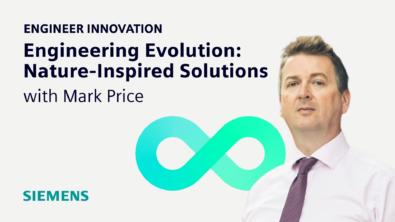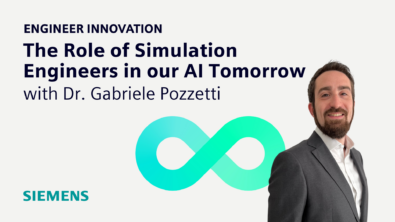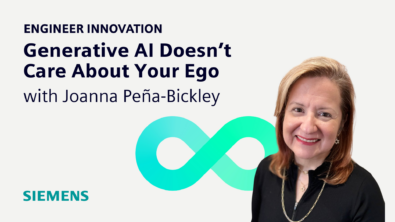From concept to reality: AI and the digital twin at Realize LIVE
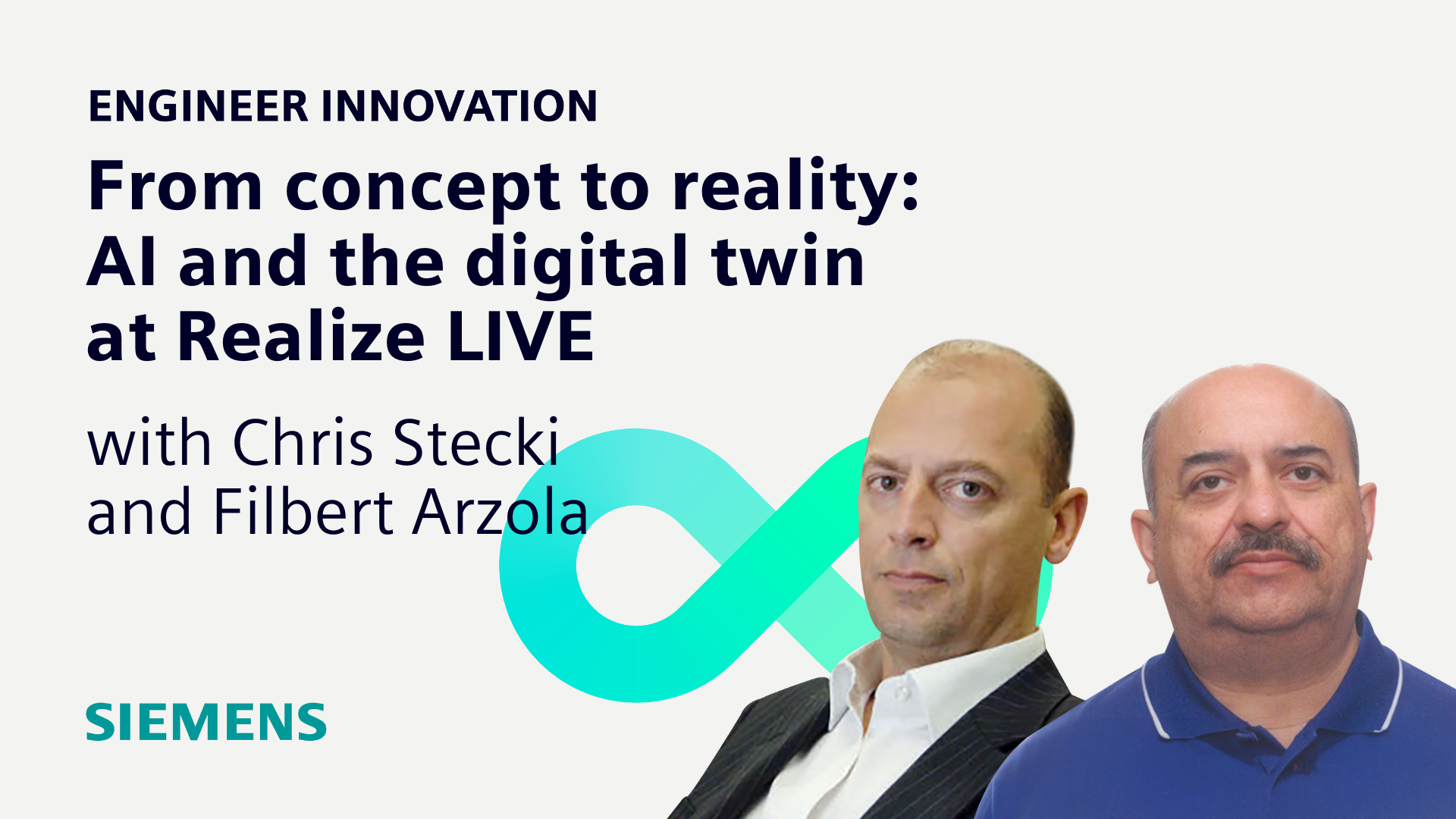
Guest Chris Stecki and Filbert Arzola
Listen on Apple
Listen on Spotify
Show Notes
In this episode, we explore artificial intelligence, digital twins and model-based engineering with Chris Stecki, CEO of PHM Technology, and Filbert Arzola, Principal Electrical Engineer of Raytheon. Recorded live at Realize LIVE 2024 in Munich, we discuss how these technologies are changing the engineering field.
Learn more about how AI is used in engineering, the effects of digital twins on product development, and future engineering innovations.
Key Takeaways:
- AI in engineering requires critical domain knowledge and cannot replace engineering expertise.
- Digital twins have a transformative impact on engineering practices, especially in PCB design, by enabling simulation and model-based approaches.
- AI’s role in engineering processes must include human oversight to ensure accuracy and reliability.
This episode of the Engineer Innovation podcast is brought to you by Siemens Digital Industries Software — bringing electronics, engineering and manufacturing together to build a better digital future.
If you enjoyed this episode, please leave a 5-star review to help get the word out about the show and subscribe on Apple or Spotify so you never miss an episode.
Watch on YouTube
Guest biographies and episode transcript
- A cautious view on AI in engineering, emphasizing the importance of domain knowledge. (03:29)
- The significant impact of digital twins on engineering, particularly in PCB design. (06:36)
- The role of digital twins in preserving expertise and knowledge in engineering. (13:00)
- Future trends in PCB design and RAMS, and the importance of digital tools. (17:16)
- The necessity of human oversight in AI applications within engineering. (20:00)
- Insights into the Gartner hype cycle and the maturity of digital twins and AI. (23:07)
[00:00:00] Stephen Ferguson: Can you hear us now?
[00:00:01] Phil Arzola: Can you hear us testing? Yeah, yeah, yeah. Okay. Testing one,
[00:00:04] Stephen Ferguson: two. I guess we just start, don’t we?
[00:00:06] Phil Arzola: It’s up to you guys. I’m just following your lead.
[00:00:10] Chris Stecki: It’s like being at home. I talk and I’m not sure if my wife listens. She’s not sure if she can hear me. I know, mine’s not.
[00:00:15] Stephen Ferguson: Save the gags for the recording, please.
[00:00:19] Chad Ghalamzan: It is being recorded. We can get going. I take that back. My wife always listens. Yes, of course. Sorry, I don’t want to record it. It’s being recorded and live streamed right to your house. So, uh
[00:00:56] Chad Ghalamzan: Steven, we have two distinguished guests with us today. We have Chris Stecky from PHM Technologies and Phil Arzola from Raytheon. Thank you for joining us. We’re live here in Munich at Realize Live.
[00:01:11] Stephen Ferguson: And in front of a live studio audience for the first time ever. Usually it’s me and you separated by about what?
[00:01:18] Stephen Ferguson: 400, 000 kilometers. Yeah. And even still, we’re opposite ends of the stage, so we don’t have to interact too much, but it’s a bit weird being close to you and actually recording one of these.
[00:01:26] Chad Ghalamzan: Yeah. I can almost touch you, which is not something we’re supposed to be able to do when we do this, but no one told me they’d be touching.
[00:01:34] Chad Ghalamzan: I heard that. I was going to say, wait a minute. Well, you didn’t, did you see the, you know, Try it, see it, feel it. I should have taken the message. So, both of you have been here at Realize Live Munich with us. What’s your impression of the event so far? Uh, I think
[00:01:51] Chris Stecki: for me it’s always interesting to get a large number of people that are broadly working in the same space but of course, uh, for us we have a particular interest and the opportunity is really to find people that are From all of these people, the people that are interested in your particular stream.
[00:02:08] Chris Stecki: Um, so yeah, I think, you know, one, it’s nice to be part of the large crowd, but it’s also really useful to meet the people that specifically want what you have or what you’re interested in. So yeah, I, that, that part’s really interesting for me.
[00:02:21] Phil Arzola: You, Phil, for me, it’s the first time I’ve, I’ve attended a Siemens realized live, I did go to the Vegas show.
[00:02:28] Phil Arzola: This show for me has been much more. It’s been. I could really attach and get with the people, meet with them, talk more. The classes are all, some of them are similar, but it just seems more exciting here. I don’t know why, maybe it’s because it’s Munich. Munich is an exciting place. I love it, but what it’s really been for me is that I’m a board designer.
[00:02:49] Phil Arzola: And to see all the other stuff that’s going on around what I do really makes me want to become involved with more stuff. And that’s what’s really the key takeaway for me from this show. Definitely. Really, really had a good time here.
[00:03:05] Stephen Ferguson: Yeah. It’s just been a big celebration of engineering, isn’t it? So once a year, I feel like I update all my engineering knowledge.
[00:03:11] Stephen Ferguson: It’s like a big step change. You understand exactly what’s happening, what the bleeding edge is, and what we’re going to be talking about to people for the next year. So I’ve, I’ve really enjoyed that kind of data upload and the chance to meet loads and loads of brilliant engineers doing some quite inspiring things.
[00:03:27] Chad Ghalamzan: So we, we had four main themes presented by Joe Bowman, uh, yesterday on the main stage. One of them was artificial intelligence, which I think we’re all seeing more and more. I’d be curious to hear, uh, our guests thoughts on artificial intelligence. How do you think it’s impacting the way you work? What did you hear this week on the topic that you thought was interesting?
[00:03:48] Chad Ghalamzan: Was there any aha moments for you in any of the presentations you got to see? Thank you. Um,
[00:03:54] Chris Stecki: I might be a little bit contrarian here, but Please, go ahead. Uh, so, um, first of all, you know, we see AIs impacting everything and everyone’s talking about it. But, um, I’m, I’m hesitant. for people to, particularly for, uh, you know, particular engineering tasks and so on.
[00:04:14] Chris Stecki: You can’t use AI to replace engineering knowledge and process. Um, and so I think the, the, uh, the interesting thing that I’ve noticed is that, you know, everybody is looking to use or utilize, uh, AI more broadly, data science and so on. Um, but I think the, you know, the important thing is going to be that people are able to tie that back to the engineering, the causation, the causality around it.
[00:04:38] Chris Stecki: Um, and I think that you’re starting to see that in some of the applications that putting, you know, that I’m, that I’m seeing around that people aren’t just, you know, inventing things with AI that don’t make any sense, you know, because it’s an engineering conference, it has to be grounded in the engineering knowledge and so on.
[00:04:54] Chris Stecki: So I think, um. A push towards that, people trying to use AI for specific engineering tasks, rather than, we’re using AI just generally, is what I’d do. I’ve seen here.
[00:05:06] Stephen Ferguson: So Chris, in your presentation yesterday, you talked about this kind of not conflict, but, but who a territory battle perhaps between data scientists and engineers for who gets to control AI and who’s making the decisions.
[00:05:19] Stephen Ferguson: And you have some pretty firm opinions on that.
[00:05:23] Chris Stecki: Okay. All right. You’re trying to get me into trouble here. Okay. Right. Yeah. So I guess our view is that, uh, in our domain, right. And we look at, uh, Rams reliability, availability, maintainability, safety and diagnostics. Um, so in that domain, I guess for us, um, we think that data science is useful, but it’s useful in the context that the engineers decide rather than data scientists or AI people coming in and saying, Hey, we’ve got this new technology.
[00:05:52] Chris Stecki: How can we apply it to engineering? I think it should be the other way around. There are engineering problems that need to be solved. And when people think about how they can be solved, AI can be applied. Okay. Um, so, I mean, there’s room for both. Obviously, I sit in the engineering camp because we’re an engineering company and, and, and so on.
[00:06:08] Chris Stecki: Um, but I think more and more there’s going to be, uh, interplay between them. I think the, the, the interesting thing will be how much control, if you will, the engineers have going forward. Um, so that it doesn’t just up, you know, it can’t be autonomous. Engineering. I don’t think yet can be done autonomously.
[00:06:27] Chris Stecki: You need to have the human in the loop. Um, and that’s because they bring the domain knowledge and the understanding and everything else. Um, so I think engineers are still in a pretty good position for the next, uh, foreseeable future.
[00:06:39] Stephen Ferguson: Which is a relief to me.
[00:06:43] Chad Ghalamzan: What about you, Phil? You’re coming from PCB background. What’s your thoughts on this?
[00:06:47] Phil Arzola: You know, and you mentioned PCB, you know, design engineering. That’s what my main, I have two. Qualifications that I’m trying to push out there to all all of the board designers in the world. We’re not drafters We’re not tracers.
[00:07:02] Phil Arzola: We used to do all that and we’re good at it. And sometimes we don’t mind that badge of honor But we are now PCB design engineers doing boards nowadays is not simple. It’s very complex it doesn’t matter what board type you’re working and it’s been It’s quite exciting to know what the future has for the board designers that I’m helping to mentor where I work But in terms of the four, you know, like AI, digital twins, cloud, IOT, the one that really excites me the most is digital twins.
[00:07:33] Phil Arzola: And the reason it does is because I, I’m an old dog. I’ve been doing this since 1979 when I did my first board as a sophomore in high school. And when I really got into the industry, we were designing boards because we wanted to replace wire harnesses and reduce labor. And You know, it’s just one of those things you really want to design boards, engineer them to the best, but not have to build.
[00:07:58] Phil Arzola: We called it a brass board, a proof of design, a proof of concept, an experimental board. Why make all that hardware when you can simulate what you’re going to do, which is what digital twins to me really does. And that just opens less costs, less time. Time to production is going to be a lot faster, a lot smoother.
[00:08:19] Phil Arzola: Your only biggest issue hurdle is going to be assembly, but we’re already doing pretty good with that, with the IPC, you know, cause I do a lot of stuff with them as well. So my biggest takeaway from all those AI, not too much so yet, but I got to understand it. My company hasn’t been driving toward that yet.
[00:08:37] Phil Arzola: I think we will eventually, but I think, uh, I can convince them to move toward digital twins for sure. Cause saving money is a big deal, but yeah.
[00:08:46] Stephen Ferguson: Yeah, I mean, I think having come to these conferences where in my case for the past 25 years, basically every year and we’ve been talking about digital twins for a long time.
[00:08:55] Stephen Ferguson: Yeah, and so it’s really quite relieving for me to see them actually coming into being used properly in industry as well. And Chris, I think you talked about different types of digital twins. Yes, in your presentations, there’s not just one digital twin, there’s several.
[00:09:08] Chris Stecki: I think, I think that’s like, uh, people talk about model based engineering and, uh, and the biggest fallacy is if you have one model that you can use it for everything.
[00:09:16] Chris Stecki: And of course, each model is designed for a particular purpose. And, and, and again, Phil, you and I must be both old because, um, what they now call digital twins is actually what I think about as a proper model, right? With simulation and so on. Lean
[00:09:29] Phil Arzola: engineering.
[00:09:29] Chris Stecki: Yeah. So, um, I think the, the concept, so we have a concept of.
[00:09:33] Chris Stecki: Uh, digital risk twins and digital diagnostic twins because they’re the, they’re the things that we’re looking at. So I think that, you know, the, the, the push towards digital twins is, is not going away. Everything has to be model based and engineering. Um, and I think that, you know, there aren’t many pockets of engineering left really that aren’t trying to use digital twins.
[00:09:54] Chris Stecki: Um, And sorry, going back to your earlier point, Chad, if you have the digital twins, then you can start to use AI in an informed, meaningful way. Yeah, I think, yeah,
[00:10:05] Stephen Ferguson: I think that’s part of it, is that all of these concepts, the metaverse, digital twin, AI, When we started doing the podcast, we wanted to talk about those as if they were separate topics, but they’re not really, are they?
[00:10:15] Stephen Ferguson: They all merge into one and it’s basically the future of engineering, I think.
[00:10:18] Chad Ghalamzan: Yeah. Yeah. And, and, and it goes to something you just said too. I mean, you said, um, you, you don’t call it digital twin, you call it the simulation model, right? I mean, is, are these labels fundamentally changing the way you’ve worked?
[00:10:31] Chad Ghalamzan: I mean, you both have 20 plus years, I think, uh, experience. Have you, are you seeing, you know, The way you work change. Are you just seeing the labels change? Do you think these technologies are merging together to make your job easier, but you’re still kind of following the same process as you did before?
[00:10:44] Chad Ghalamzan: I
[00:10:45] Phil Arzola: think it’s
[00:10:45] Chad Ghalamzan: a little bit of
[00:10:45] Phil Arzola: both. I mean, we’re, we’re, you know, 50, 50, we’re, we’re still going to design the way we do. You know, uh, we, we tried to go that same path because it’s been a path of success, but in order for us to sustain and move forward and be competitive in the world, um, We got to do what everybody else is stampeding toward and, and we’ll do.
[00:11:05] Phil Arzola: Okay. And going back to your model based design, I love model based design, but, and I totally agree with you. It’s not unique just because I do it for one board type doesn’t mean it’s going to apply to all the others. You have to have unique settings, good formatted setups, a good working community, good design loop.
[00:11:23] Phil Arzola: Team, you know, good design team loop, and then you can get everything done and still consider the model as a very perfect way to get things done. But. I see us heading more toward using digital twins only because we do a lot of signal and power integrity analysis. And that’s been our main speed bump. You know, our speed bump is that we fall flat because we didn’t do the proper analysis of signals and power.
[00:11:51] Phil Arzola: And now we’ve got to restart. And that wastes time, that wastes money, that wastes production. It slows us down. We want to be at the front. That’s just the way our company is driven. And by doing that, we need to get into simulated fabrication and simulated growth through design first. And then we got to focus on the assembly and selling of the product.
[00:12:17] Phil Arzola: But yeah. I think I answered your question. I hope I did. Do
[00:12:22] Chris Stecki: you have anything that, uh, so it’s a little bit different for us. So we’re a partner of Siemens and we sell, um, technology for, you know, we’re at technologies for Rams. Um, and I think the big change has been for us that, um, it’s one of the last bastions of authoring data.
[00:12:40] Chris Stecki: Um, you know, the safety experts, the reliability people, um, have, you know, tenaciously held, you know, their ability to have in a sense, artistic license to create this, this information. Um, but I think that it’s the complexity of, um, the systems that people are trying to develop now. It takes it beyond the can of a manual analysis.
[00:13:01] Chris Stecki: So, I mean, we’ve been pushing model based approach since 2007. Um, but what’s changed for us in the last three or four years, we’ve started talking about digital risk twins. By the way, it’s the same thing. Um, but
[00:13:15] Phil Arzola: lean engineering is what we used to call it. Yeah,
[00:13:17] Chris Stecki: but but all of a sudden now We’re we’re highly topical and where people are really interested so, I mean, I think some of the flavoring is is around maybe the marketing and positioning and so on but Again, I think I’m with Phil here.
[00:13:30] Chris Stecki: We come back to the core engineering principles and you know realistically for us If you call it a simulation model or a digital twin or parallel twin As long as it does the proper engineering. That’s what we care about. Um, but I noticed that there are particular buyers that seem to be attracted to the, you know, they want to have the latest thing.
[00:13:51] Chris Stecki: So. I don’t know if I really answered that question. Quite a banana. You did, but I’m just
[00:13:56] Chad Ghalamzan: very curious now
[00:13:56] Chris Stecki: what bananas are like
[00:13:57] Chad Ghalamzan: in Australia. Because we do a lot of work with
[00:14:01] Chris Stecki: defense and I can’t really talk about it. It’s a top secret banana. So, so
[00:14:07] Stephen Ferguson: you talked a bit about reliance on experts. Is a digital twin an opportunity to embed some of that best practice?
[00:14:13] Stephen Ferguson: So it’s not stuck, you know, the Chad’s quite young, but the three of us on stage. Yeah, we’re kind of at the back end of our careers. And I think every time. That an expert retires. Sorry about that. You’ve been going since 1979. You make me feel young. But every time we lose an expert from the industry, that knowledge disappears, doesn’t it?
[00:14:34] Stephen Ferguson: And especially, you know, in a world which quite often we have recruitment crises where we can’t get a hold of good people. Is there an opportunity to embed that best practices into your digital twins?
[00:14:46] Chris Stecki: If I can go first Phil, I’ve got a strong view on this one. We think that’s a really important thing. So, digitizing domain knowledge, um, and being able to, um, try and capture some of that understanding that goes around You know, specific parameters and everything else, that context, um, so a way to capture that.
[00:15:04] Chris Stecki: So the model, um, if you can build the model with the input from the subject matter experts, I think that’s, that’s what we advocate to our, our customers. And I mean, in our domain specifically, so, um, A lot of the people in an aerospace and defense, there’s a, what the, you know, the silver tsunami, right?
[00:15:22] Chris Stecki: There’s a whole lot of people that were there that went out. Um, and as a consequence, I think that, you know, you’re seeing availabilities. A lot of the, the systems that people are using in defense, you know, they’re not getting the expected availability and you’ve got to sort of wonder, is it because the guys that knew how they could sort of tweak it aren’t there anymore.
[00:15:40] Chris Stecki: So absolutely. We think that, you know, if you don’t capture that knowledge in a way that can be used going forward, then you’ll make the same mistakes again. And that doesn’t make any sense.
[00:15:51] Phil Arzola: I, I, I agree with that for my company. We’re so customer driven and we have a certain product line and we continue to push that product line because not only does it pay the bills, but it satisfies our customer’s needs and you have to satisfy your customer’s needs.
[00:16:06] Phil Arzola: It doesn’t matter who your customer is. You need to make them happy, but I’ll tell you if the customer heard about digital twins, you can bet the next day, our VIP of engine or VP of engineering is going to call us and say, What on earth is digital twin? You know, and you’re going to be like, I don’t know, you know, and I’ll get a phone call because they heard I went to a show or something and then I’ll have to go and explain it to them, which I don’t mind doing.
[00:16:32] Phil Arzola: I really would love to do that because I’d like to push that in my company. But being part of a huge company, the way I am, it makes it a little more difficult to get folks in line to accept this and move forward. But I think we can. I mean, I really believe that we should. And it’s going to take some time to get everyone retrained with the software methodologies, guidelines, how we do things.
[00:16:57] Phil Arzola: We’ll still follow IPC, but to get everyone in line and thinking this is a better way to do it, that’s the tough part. But we’ll find a way. Can I just
[00:17:09] Chris Stecki: add one more thing on that? Absolutely. So, I think the interesting thing that we’ve seen is um, A lot of the junior engineers that are coming through now, uh, completely used to digital.
[00:17:17] Chris Stecki: So for them, if it’s not model based or, you know, like a digital twin, it, their question first is why. So I think, you know, one is that you have to make it an engaging workplace for the younger engineers. Um, so that’s, that’s a, it’s a benefit on that side, but the other thing is, and apologies to all the young people, including my son, who’s a second year engineering student who thinks he knows more than I do already.
[00:17:43] Chris Stecki: They don’t know, right? And the main knowledge that you get from experience, um, is really valuable. I mean, it’s, it’s the difference between making mistakes and not making the common mistakes. So I think there’s a push and a pull for Digital Twins, um, which I think is playing out in slow motion across the industry.
[00:18:01] Phil Arzola: Yeah, and our young engineer, uh, influx has been going on for some time. And, you know, us old dogs like me We’re on our way out. They ask us to transfer knowledge to these young folks so that we know why wait until when I’m ready to go. We’ve been doing mentoring all along. I have a, um, one of my, uh, one of my PCB designers, she came into the company as a mechanical engineer and wanted to do antenna housings and do this.
[00:18:31] Phil Arzola: And then I said, well, slow down. How about we do some boards? And we got her to do some boards and now that’s all she wants to do. She’s gone from in four years, she’s gone from making the easiest board to doing RF type boards. And, and she’s gained a lot of respect from all the folks. The only thing is she can be a little bit of a, you know, a hard edge, but she learned that from me.
[00:18:52] Phil Arzola: And so I get a little tear in my eye when I think, when I see her just pushing back and saying, we’re not going to do it that way. We’re going to do it this way. But yeah, I agree with what you’re saying. Um, it’s hard to get. Transfer that knowledge to them, but it has to happen. It has to happen. And it’s better that they start with something that’s more in the now and make it happen.
[00:19:15] Chad Ghalamzan: So is artificial intelligence a way to transfer that knowledge as well? Or no, I’m getting a lot of no’s. I’m not,
[00:19:22] Phil Arzola: I’m not, I mean, I’ll be honest. I I’m not totally 100 percent up to speed on AI. I mean, you hear it in the news, you read it in the paper, you go to trade techs, But, you know, for me in the world, I am the only thing that’s really stuck out as digital twins, because I look at it as analysis.
[00:19:42] Phil Arzola: I look at it as what makes my job better. How can I be a better engineer, do my job, not just get the board off my plate and go on to the next one, but also talk to everybody else in my section about how we did it so that if they get that same job, they can do it with the same success.
[00:19:59] Chad Ghalamzan: So could you put your.
[00:20:01] Chad Ghalamzan: future looking glasses on for a minute and think five years from now, where do you think PCB design is going to be, uh, Phil and for you, Chris, maybe you could talk about where you think Rams will be five years from now. So maybe you can go first. So.
[00:20:14] Phil Arzola: Okay. So, uh, I’m a UC Davis grad go eggs. And, and, and one of the things that I’d like to do is, and I haven’t taken the time yet, but I want to try and go back to the UC system.
[00:20:26] Phil Arzola: And try to convince them to start a university program, university courses on how to do PCB design engineering and get them to take a class or two. There’s some universities in the U. S. that are doing that, but it’s just one or two, maybe three. I’d like to see it ripple through the U. C., because there’s, I think, more than ten universities now in California U.
[00:20:49] Phil Arzola: C. related. UCLA, UC Riverside, all those things. I’d like to see them have a class that they can take so that when they’re working their mechanical or their electrical or their aeronautical or material science degrees, they can also take a shot and look at what boards are all alike because that’s one of the things we really like to start people off at.
[00:21:08] Phil Arzola: Why? Because there’s a board in everything. 98 percent of the objects in the world have a board in it. I bought an air freshener. I had to plug it in. What am I plugging it in for? And then I, you know, I’m an engineer, I got to take it apart, right? And there’s a board inside. I’m like, what’s a board doing inside of an air freshener, you know?
[00:21:25] Phil Arzola: But that’s just me. I see boards everywhere. That’s why it’s engineering, you know. In the future, I see boards being made a certain different way. One of the things I like to see is more vertical. Instead of parts being assembled all on top of the board, make bigger vias to carry traces and inside the vias.
[00:21:46] Phil Arzola: We can put biasing capacitors or biasing resistors inside and give us more space on top of the board in the bottom for our, for the, what we do, what we engineer, but I still think in 20 to 30 years, we’re still going to be doing things the way we’ve been doing it, but we’re going to put more into the digital tool, the digital twins and the AI.
[00:22:09] Phil Arzola: I’m just speaking for how I think my company will go.
[00:22:13] Chris Stecki: Chris. So, um, I’ll echo what you say, Phil, about, uh, it’s a, so just I’m not sure if people know what Rams is, but essentially what you’re dealing with is technical risks. So how things break in systems could be the PCB board, could be the pump, could be whatever it is.
[00:22:30] Chris Stecki: Um, and so the majority of, uh, Rams work, a lot of his A and D sort of lead the way. Um, and the interesting thing is that there are no courses that teach people how to do Rams. So you come out as a mechanical engineer and, you know, all of the engineers that we hire have never heard about, Rams. They might’ve done one subject for part of a year.
[00:22:51] Chris Stecki: Right? So it’s interesting because 80 percent of the cost of ownership for a platform is sustainment.
[00:22:56] Phil Arzola: Wow.
[00:22:57] Chris Stecki: Right? So if 80 percent of the cost relates to how you deal with this technical risk and no one gets taught how to deal with the technical risk, maybe that’s not surprising that we spend more and more on sustainment.
[00:23:08] Chris Stecki: I don’t know that Siemens is actually pushing big into SLM service lifecycle management to address that. Um, so I think, um, yeah, there’s going to be, uh, More use of AI around some of the predictive elements for what we do because we’re looking at, um, diagnostics for, you know, real time systems, what’s failing, how’s it failing, et cetera, et cetera.
[00:23:29] Chris Stecki: So I think there will be some potential to use AI for that. Um, I don’t think that you’ll ever get away from, um, you needing, needing to have a human in the loop for this stuff. Um, I certainly wouldn’t want to be on an aircraft that was completely designed by AI. Um, and I’m. I mean, you know, I think, um, The idea of being able to leverage all of the information before and synthesize that in a way that’s useful to you, if that’s what you want to describe as AI, then yes.
[00:23:59] Chris Stecki: How you practically get that to happen, I think, is where the challenge is and I think that’s not going to be a, you know, someone’s going to hit one button and everyone’s going to use it. I think it’s going to be very much case by case, where people find AI and can apply it to discrete problem spaces.
[00:24:17] Chris Stecki: Over time. So I, and then, you know, you’ll look back and say, everything is AI, like everything’s got a board, everything will have AI eventually. Um, but I think getting there will be, um, there’ll be different rates of adoption, if you will, in different. different areas. So yeah, Rams in the future. I mean, uh, we’re already seeing it.
[00:24:35] Chris Stecki: Um, you know, where some of the major AMD customers for Siemens are all starting to employ this, uh, the technology we have the digital risk twin, um, for the reasons that Phil described that it’s cheaper, it’s faster, it’s better. Uh, it means you can do concurrent engineering and actually means that you can start to think about the cost of ownership, um, earlier rather than later.
[00:24:55] Chris Stecki: So I, you know, People talk about doing it. There’s now tools to do it. I think, um, what we’re seeing now is the transition between, um, what they were doing and now starting to adopt the new piece and, and that’s starting to happen now, which is, which is encouraging.
[00:25:11] Chad Ghalamzan: Got time for one last question. Stephen, I’ll leave it to you to ask.
[00:25:13] Chad Ghalamzan: No, I was
[00:25:13] Stephen Ferguson: just going to comment on that actually. I think, I think, and I learned quite a lot from Chris’s presentation yesterday, and I quite enjoyed his cynical view of AI. And we’ve talked afterwards about how, um, You know, AI makes people, makes engineers more productive, which is a good thing because there’s not enough engineers in the world.
[00:25:30] Stephen Ferguson: We’ve got some huge problems to solve to do with sustainability and, uh, and feeding a population of 10 billion people. So we need more engineers. We need more engineering. And I think AI is a tool to make engineers even more efficient. And I think, but it doesn’t fundamentally change the core role, does it?
[00:25:45] Stephen Ferguson: We’ve still got to do, you described it as a grind earlier, and it has to be. Engineering is hard work for clever people making difficult decisions about problems that aren’t easy to solve. And that doesn’t go away. And I think, so I think AI is a useful tool. We’ll see more and more of it. Um, always interesting to see, I mean, last year there was very few mentions of AI in the presentations.
[00:26:04] Stephen Ferguson: There was more in conversations. Because for lots of people it’s not mature technology yet, they’re just starting to use it. So I think maybe in five years time we’ll be talking, you know, as we were five years time, we’ll be talking about digital twin and not seeing many digital twins. It’s going to take that amount of time to come through.
[00:26:18] Stephen Ferguson: So, yeah, I think lots of exciting stuff. I’m a big fan of the Gartner hype cycle where you see things get to peak hype. And like six, seven years ago, I think 2017, digital twin was at peak hype and it disappears into the trough of disillusionment. And I think we’re on to the, at the starts of the plateau of productivity.
[00:26:35] Stephen Ferguson: And I think the same thing will happen with the generative AI as well. So, yeah, very optimistic times.
[00:26:42] Chad Ghalamzan: And with that, I think our time’s up. I want to thank our guests, Chris and Phil, for joining us. Thank you so much. And a big round of applause from our audience. Great being here.
[00:26:50] VO: That
[00:26:56] Stephen Ferguson: was great. All right.
[00:26:57] Stephen Ferguson: Thank you guys. That was amazing. We’re not done.
[00:26:59] Chad Ghalamzan: We’ve, we’ve done a couple of podcasts together, but we’ve never done one in the same place at the same time. This is a unique experience for us. We did, we did
[00:27:09] Stephen Ferguson: record some in a room upstairs, didn’t we? That’s true, that’s true. Which wasn’t quite the same thing. No, we were on a stage. It’s a different dynamic being in front of a real audience and seeing their responses.
[00:27:19] Stephen Ferguson: Yeah. And having two such great guests as well, who made it really easy for us.
[00:27:22] Chad Ghalamzan: Yeah, they were fantastic guests. So we’re. What was your biggest takeaway from this week?
[00:27:29] Stephen Ferguson: It’s, as usual, it’s just having conversations with people. I mean, you can sit in the presentations and you learn a lot from the presentations.
[00:27:35] Stephen Ferguson: But it’s catching up with people outside the presentations and at the bar. And we spent quite a lot of time at the bar this week as well. And just having conversations about, with people from different discipline areas. Not necessarily the things that you’re comfortable with. And just learning, you know, learning from them.
[00:27:51] Stephen Ferguson: And there’s, there’s not a single session I’ve sat in this week where I haven’t learned something important. So
[00:27:56] Chad Ghalamzan: what I, and for me, and it’s, and it’s going to go bid against what our guests were saying, but last year when we came here, AI was, was all abuzz. It was not long after. We had, you know, chat GPT come out and everyone was talking about AI, but it wasn’t, it wasn’t, hadn’t had a chance to be maturely implemented in most companies process here this year, we’ve seen a lot more presentations from companies using AI and already getting a return on that investment and investing and implementing it and changing their process or changing their, their, their, their way of working to incorporate it and leverage what it offers.
[00:28:33] Chad Ghalamzan: But, um, it’s, it’s, it’s almost like. We went from, Oh, this is, this is great. This is new. What will it do to, okay, this is how it’s working for us in a very, very short amount of time, it didn’t take long for companies to draw and it goes to something we, and you have talked about before in terms of what we call the adjacent possible, because so much of what companies are leveraging and what AI offers isn’t actually new.
[00:28:55] Chad Ghalamzan: AI has been in the development for decades, but it’s only in the last couple of years with the ability for. People to interact with it through LLMs to natural language that made the rest of this capabilities accessible. And we’ve talked about how it’s gone from just in the hands of data scientists to everyone.
[00:29:11] Chad Ghalamzan: And I think that’s why there’s been a big shift here. And I see that in some of the presentations that it’s because it’s now just easier to access. The full breadth of AI capabilities and machine learning capabilities through LLMs, you’re seeing more companies try to adopt it.
[00:29:23] Stephen Ferguson: Yeah, and I think that’s, that’s the thing about LLMs.
[00:29:26] Stephen Ferguson: You know, it’s a use of AI technology, but it enables you to do so much more. Because I think, you know, most of, I’ve, I’ve basically spent most of my career using, Well, two CFD packages, yeah? Star CD, then Star CCM, Simcenter Star CCM Plus, yeah? And, you know, I can do that because I learnt to use the interface, I know which buttons to click, yeah?
[00:29:44] Stephen Ferguson: That’s, you know, if I went to pick up a different competitor CFD code, that would be a struggle for me, because I don’t, because I don’t know how to use the interface. I know that the simulation procedures are almost identical, I presume. Right, right. But it’s, LLMs give us the ability, To, to, to interact with software without using all the clicks, all that kind of unnecessary learning that you have to do, and also work in a multi disciplinary dose, because you know, I studied FEA at university, I’ve done none of it, because I can’t use the tools, so I think, you know, maybe not me, because I’m quite old, but the next generation of engineers are not only going to be fluids guys, not only going to be stress guys, not only going to be, you know, systems guys, I think it enables us to do much more.
[00:30:24] Stephen Ferguson: And think about problems in a much more holistic and kind of all encompassing, all encompassing way.
[00:30:30] Chad Ghalamzan: Yeah. And, and to extend what you’re saying and pick up on what some of our guests were saying too. I think it’s not about the data and it’s not about the accuracy and it’s not about having all this information.
[00:30:42] Chad Ghalamzan: It’s using it intelligently. It’s being, having it accessible and available and then making decisions. It’s the right decisions based on the right data at the right time. Because I think we’ve reached a point where we have a sea of information or data available to most, most of us to, to make these decisions.
[00:30:58] Chad Ghalamzan: But it’s, it’s working through it and, and having that right information to make the decisions. AI helps us do that, but that’s the other thing I would say I would learn from attending presentation this week. So it’s all about making intelligent decisions and that come, come from AI or could come from just being more integrated with the tool sets that we have.
[00:31:17] Chad Ghalamzan: So it just. Ability for information to be available when you need it, how you need it.
[00:31:22] Stephen Ferguson: Yeah. Yeah. Cause again, at the start of my career, you know, if I wanted to do an engineering simulation, some of my first engineering simulations took, took months. And if you came back and you made a mistake and now on the podcast recently, we’ve been talking to companies like physics X.
[00:31:36] Stephen Ferguson: Yeah, he was talking about doing 100, 000 simulations a day. And what 100, 000 simulations a day allows you to do is fail more quickly, more often, learn from those mistakes and then build better products and processes. So I think that’s what really this acceleration of simulation or AI augmented simulation will do to us.
[00:31:56] Stephen Ferguson: It gives us more opportunity to learn from our mistakes by making more of them.
[00:31:58] Chad Ghalamzan: Yeah, and you know, take what Physics X is saying about doing 100, 000 simulations a day. Yeah. If you’ve got a deadline with the way they’re implementing that tool, if you only have, let’s say a week to work on a project, instead of being able to only do 50 or 60 design iterations, you’re able to do way more because of that.
[00:32:17] Chad Ghalamzan: So it’s, you can look at it both ways, both in terms of how much more you can do or even in the time you have, how much more you can accomplish than you did before by using these tools. in an intelligent way.
[00:32:27] Stephen Ferguson: And also to understand all the uncertainties that surround modeling, because whenever we set up a model, we make certain assumptions be about boundary conditions or modeling coefficients that we use.
[00:32:37] Stephen Ferguson: If you’re doing a lot more simulations and you can tweak all those parameters, change them around and get more of a stochastic view of the solution. Instead of coming up with a single drag coefficient or a single pressure drop or a single, you know, temperature rise. What you can do is you can say, you can start thinking about things stochastically and look at a statistical, probabilistic, uh, variation in, in those output parameters and that gives you a much better view.
[00:33:00] Stephen Ferguson: So, because I think quite often the simulation engineers, you get your answer and you think it’s the answer when in fact it’s just one of a range of possible answers. So I think that kind of acceleration is going to change the way we think about simulation in the same way that it’s changed the way we think about weather forecasting.
[00:33:14] Stephen Ferguson: So, when you see a weather forecast saying there’s a 40 percent chance of rain. That means they’ve done a thousand simulations or so, perhaps, and 40 percent of them said it’s going to rain at that time. And that kind of probabilistic outcome is a much better way, I think, of thinking about engineering in the real world.
[00:33:33] Chad Ghalamzan: Well, my friend, I think we’re out of time as well. Yeah. I don’t know If we’re going to be able to do this again before next year, this was fun. I know we never get to host these together. So I
[00:33:43] Stephen Ferguson: love recording the podcast because it’s always really intimate. It’s very different here because we sat on a stage side by side with people looking across when you’re doing a podcast, we’re either staring down the screen at people or sometimes.
[00:33:53] Stephen Ferguson: face to face, which is quite intimate, but there’s a different dynamic, isn’t there? About doing things live. Yeah. Yeah. And getting real feedback. Uh, both the guests, they were absolutely excellent. Yeah. We were very, very privileged to have those guys on the podcast. Um, but I’d like to do more of these. I’d like to do more of these in front of an audience because you know, and get more audience interaction next time as well and ask the audience some questions.
[00:34:12] Chad Ghalamzan: Absolutely. And I think we both had a lot of fun here in Munich realized live Europe. 2024 is Ending today, but we’ve had a lot of fun so far. We’ve learned a lot. We met with a lot of interesting people. We have one more day before we call it wraps here, but this is going to be the end of this episode of the engineer innovation podcast.
[00:34:33] Chad Ghalamzan: If you like what you’ve heard, please make sure to follow and subscribe. You can find us on Apple, Spotify, or wherever you get your podcasts and reach out to us. We love hearing from our audience. We’d love to know what topics you’d like us to cover, or if
[00:34:46] Stephen Ferguson: you want to come on the podcast
[00:34:47] Chad Ghalamzan: as well, always looking for exciting guests.
[00:34:49] Chad Ghalamzan: Exactly. And on that. I’m going to say thank you for listening. I’m Chad Galamzan, and I’m Steven
[00:34:54] Stephen Ferguson: Ferguson,
[00:34:55] Chad Ghalamzan: and we’ll talk to you soon.
[00:35:00] VO: This episode of the engineer innovation podcast is powered by Simcenter. Turn product complexity into a competitive advantage with Simcenter solutions that empower your engineering teams to push the boundaries, solve the toughest problems, and bring innovations to market faster.
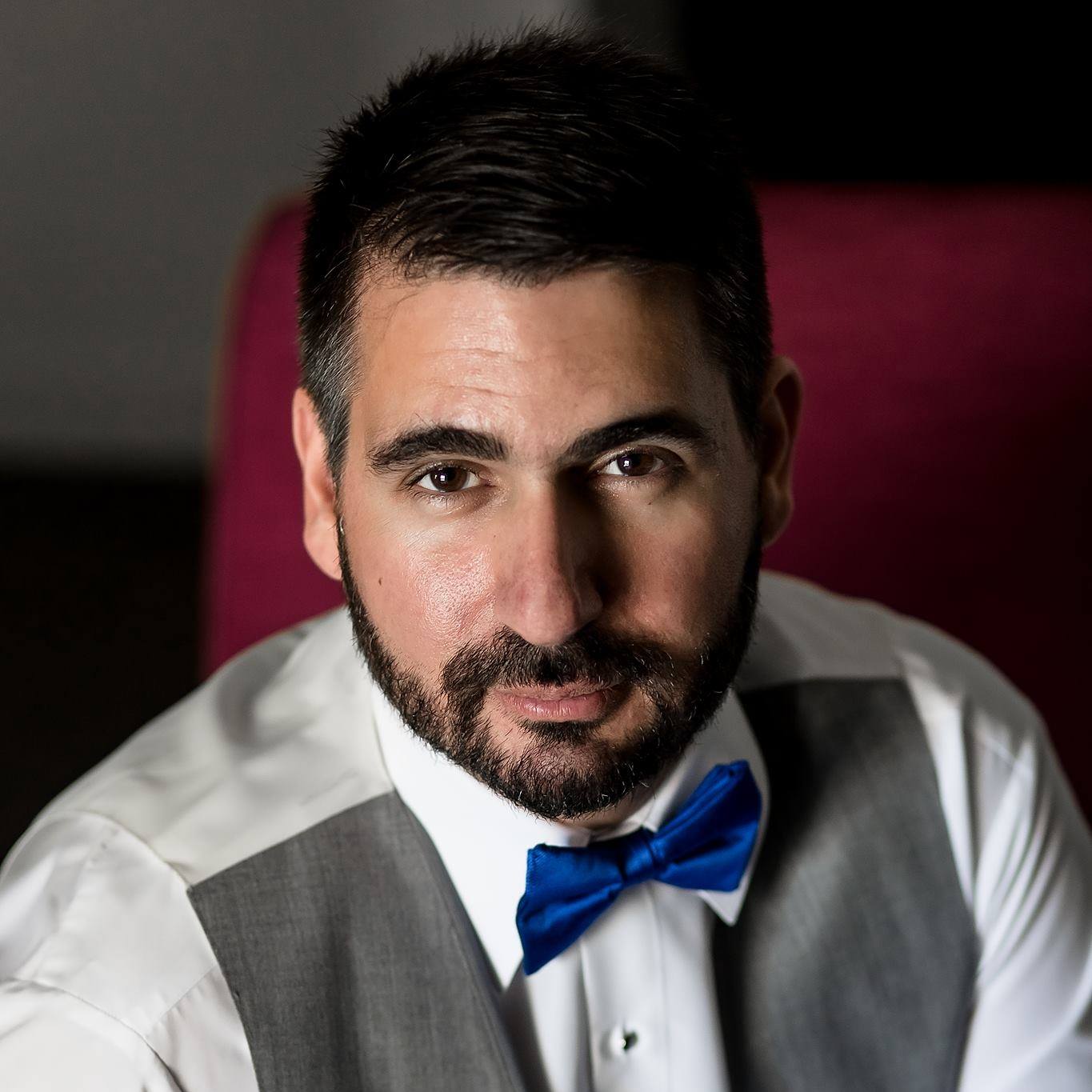
Chad Ghalamzan – Host
Chad Ghalamzan is a computer engineer with over two decades of experience in sales and marketing for the simulation and test industry. He co-hosts the Engineer Innovation podcast and creates content for Siemens Digital Industries Software.
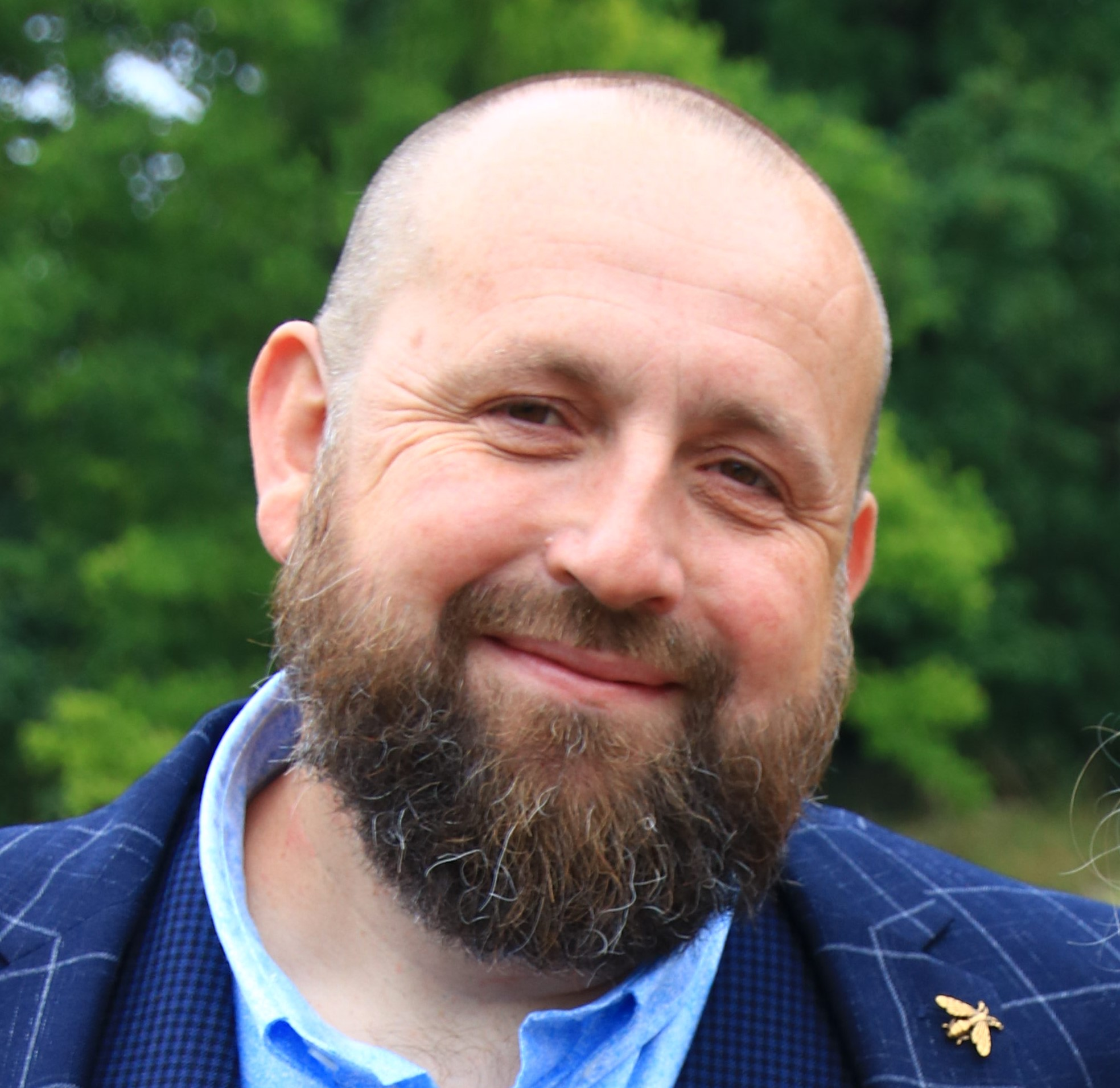
Stephen Ferguson – Host
Stephen Ferguson is a fluid-dynamicist with more than 30 years of experience in applying advanced simulation to the most challenging problems that engineering has to offer for companies such as WS Atkins, BMW and CD-adapco and Siemens.
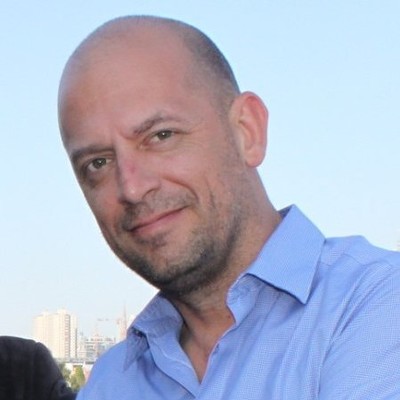
Chris Stecki
Chris Stecki is the Co-Founder & CEO of PHM Technology. He is a frequent presenter at industry and technical conferences on engineering system design, RAMS and AI. He has co-authored a number of technical papers relating to RAMS aspects of the engineering design process, and the engineering methodologies and techniques that are used in the MADe software.
Chris is an ‘enthusiastic’ Collingwood fan (Australian Football) who lives in Melbourne (Australia) with his wife and 3 children.
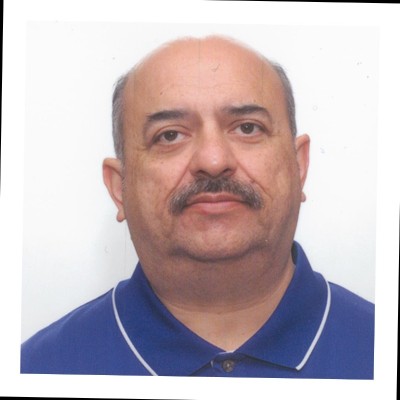
Filbert Arzola
Filbert Arzola is a Senior level Electrical Engineer that works to design and engineer Printed Circuit Boards (PCB). He is a graduate of UC Davis and has worked in the commercial, industrial and aerospace arena of Electronic Packaging for 35+ years. He is a process driven PCB Design Engineer and excel at miniaturizing microelectronic packaging for all kinds of different design purposes and applications. Filbert enjoys teaching others how to develop engineering mentalities and methodologies to help them engineer their PCB board designs. His hobbies include reading, watching football and hockey games, listening to all kinds of music, especially metal.
Take a listen to a previous episode of the Engineer Innovation Podcast: Engineer Innovation: Sky’s not the limit: AI and data management redefining space exploration with Tom Stoumbos on Apple Podcasts
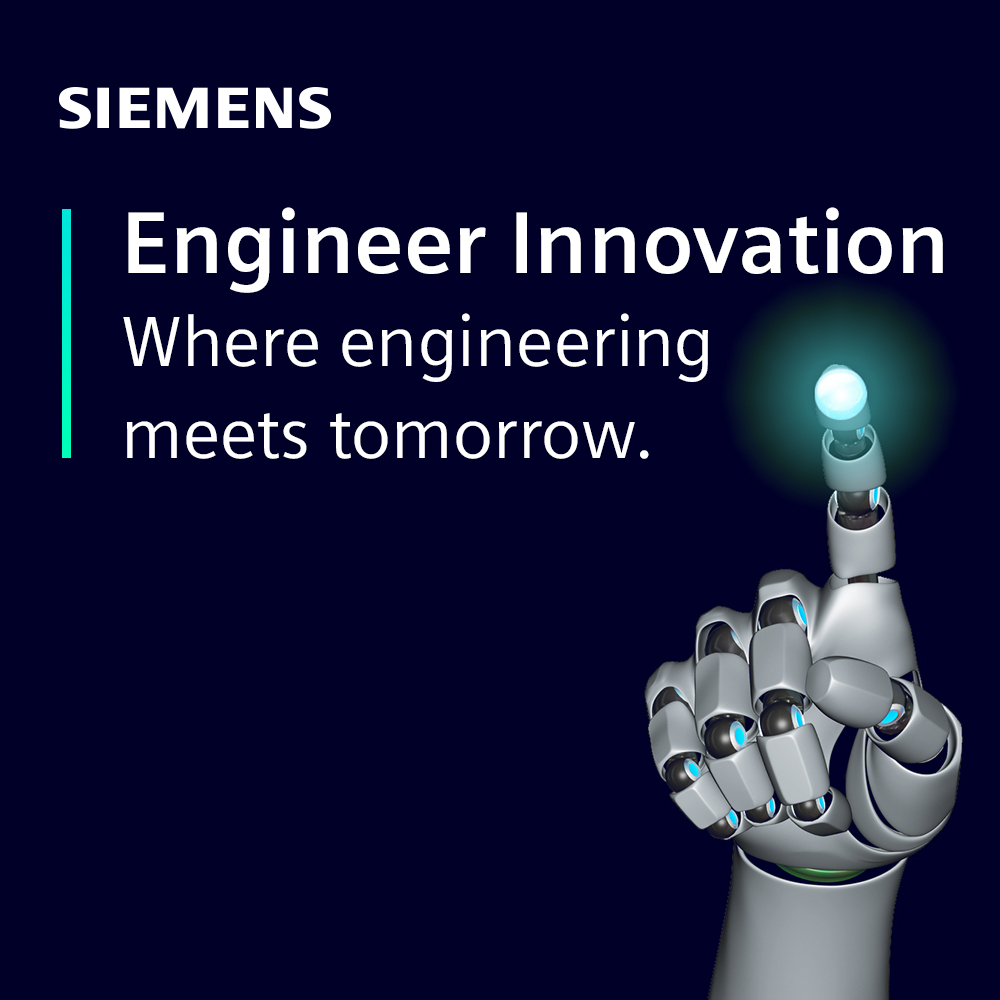
Engineer Innovation Podcast
A podcast series for engineers by engineers, Engineer Innovation focuses on how simulation and testing can help you drive innovation into your products and deliver the products of tomorrow, today.
